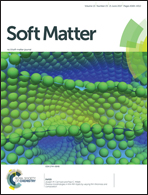Morphological explanation of high tear resistance of EPDM/NR rubber blends
Abstract
The fatigue properties of cross-linked blends of ethylene propylene diene rubber (EPDM) with low natural rubber (NR) content and reinforced with carbon black (CB) are studied. It is found that such EPDM/NR compounds have superior crack growth resistance and fatigue lifetime. For low NR contents, transmission electron microscopy reveals that the NR phase forms small droplets of 20–50 nm. Remarkably, these droplets are even smaller than the primary CB particles. Atomic force microscopy shows that the the NR phase droplets have a higher loss factor and a smaller elastic modulus than the surrounding EPDM matrix. Rheometer measurements are used to study the effect of the phase morphology on the rubber mechanical properties. These rheological data are compared with the prediction of the Eshelby model describing the effect of elastic inclusions on solids. A complex interplay between the rubber phase morphology and the solubility of both the sulfur cross-linking system and CB is observed, which cannot be predicted theoretically. It is proposed that the soft NR droplets effectively inhibit the crack propagation in the EPDM matrix.



 Please wait while we load your content...
Please wait while we load your content...